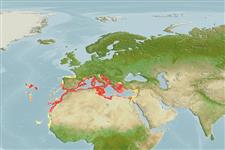>
Gadiformes (Cods) >
Phycidae (Phycid hakes)
Etymology: Phycis: Taken from Greek, phykon = seaweed; because of the habits of this fish that lives hidden among them (Ref. 45335).
More on author: Linnaeus.
Environment: milieu / climate zone / rango de profundidad / distribution range
Ecología
marino bentopelágico; no migratorio; rango de profundidad 13 - 614 m (Ref. 4517), usually 100 - 200 m (Ref. 1371). Subtropical; 45°N - 13°N, 32°W - 36°E
Northeast Atlantic : Bay of Biscay to Morocco, south to Cape Verde, and including off-lying islands. Also in the Mediterranean and the Azores.
Length at first maturity / Tamaño / Peso / Age
Madurez: Lm 36.0, range 32 - ? cm
Max length : 65.0 cm TL macho / no sexado; (Ref. 12382); common length : 25.0 cm TL macho / no sexado; (Ref. 1371); peso máximo publicado: 3.9 kg (Ref. 40637)
Espinas dorsales (total) : 0; Espinas anales: 0. Elongated pelvic-fin rays reaching at most to the origin of the anal fin. Body color is brownish-red dorsally, becoming paler ventrally. Vertical fins distally dark, sometimes with a pale margin.
Body shape (shape guide): fusiform / normal; Cross section: circular.
Found on hard and sandy-muddy bottoms near rocks at 100-650 m, but sometimes taken at greater depths (Ref. 1371). Nocturnal, hiding between rocks during the day (Ref. 1371). Feed on small fish and various invertebrates (Ref. 1371).
Cohen, D.M., T. Inada, T. Iwamoto and N. Scialabba, 1990. FAO species catalogue. Vol. 10. Gadiform fishes of the world (Order Gadiformes). An annotated and illustrated catalogue of cods, hakes, grenadiers and other gadiform fishes known to date. FAO Fish. Synop. 125(10). Rome: FAO. 442 p. (Ref. 1371)
IUCN Red List Status (Ref. 130435: Version 2025-1)
Threat to humans
Harmless
Human uses
Pesquerías: escaso valor comercial
Herramientas
Special reports
Download XML
Fuentes de Internet
Estimates based on models
Preferred temperature (Referencia
123201): 13.3 - 16.2, mean 14.9 °C (based on 84 cells).
Phylogenetic diversity index (Referencia
82804): PD
50 = 0.6255 [Uniqueness, from 0.5 = low to 2.0 = high].
Bayesian length-weight: a=0.00631 (0.00521 - 0.00764), b=3.15 (3.09 - 3.21), in cm total length, based on LWR estimates for this species (Ref.
93245).
Nivel trófico (Referencia
69278): 4.3 ±0.3 se; based on diet studies.
Resiliencia (Referencia
120179): Medio, población duplicada en un tiempo mínimo de 1.4-4.4 años (K=0.19).
Fishing Vulnerability (Ref.
59153): Moderate vulnerability (45 of 100).
🛈
Climate Vulnerability (Ref.
125649): High to very high vulnerability (68 of 100).
🛈
Nutrients (Ref.
124155): Calcium = 37 [17, 84] mg/100g; Iron = 0.74 [0.40, 1.34] mg/100g; Protein = 18.1 [16.8, 19.5] %; Omega3 = 0.386 [0.203, 0.736] g/100g; Selenium = 44.8 [21.7, 90.3] μg/100g; VitaminA = 15.9 [4.6, 56.9] μg/100g; Zinc = 0.586 [0.383, 0.881] mg/100g (wet weight);
